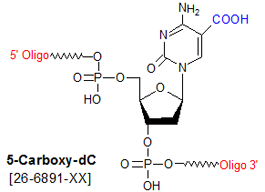
Modification : 5-ca dC
Catalog Reference Number
Category
Modification Code
5 Prime
3 Prime
Internal
Molecular Weight (mw)
Extinction Coeficient (ec)
Technical Info (pdf)
Absorbance MAX
Emission MAX
Absorbance EC
26-6891
Epigenetics
[5-ca-dC]
Y
Y
Y
333.19
7.4
PS26-6891.pdf
-
-
-
| Catalog No | Scale | Price |
| 26-6891-05 | 50 nmol | $594.00 |
| 26-6891-02 | 200 nmol | $594.00 |
| 26-6891-01 | 1 umol | $772.00 |
| 26-6891-03 | 2 umol | $1,158.00 |
| 26-6891-06 | 5 umol | $3,474.00 |
| 26-6891-10 | 10 umol | $5,728.00 |
| 26-6891-15 | 15 umol | $7,160.00 |
| Discounts are available for 5-ca dC! |
| Modification* Discount Price Structure |
|
1 site/order
|
List price
|
|
2 sites/order
|
10% discount
|
|
3 sites/order
|
20% discount
|
|
4 sites/order
|
30% discount
|
|
5-9 sites/order
|
50% discount
|
|
10+ sites/order
|
60% discount
|
|
*Exceptions apply
|
5-carboxy deoxycytosine (5-carboxy-dC) was first synthesized in 2007 by Sumino et al (1) as an anion carrier that, when incorporated into oligonucleotides, would result in increased duplex and triplex stabilities. Initial studies with 5-carboxy-dC modified oligos 13mer and 14mer in length showed that this modified base does indeed increase duplex stability over the corresponding unmodified oligos, but forms relatively unstable triplexes with their target dsDNA (1). 5-carboxy-dC thus potentially could serve as a duplex stabilizing moiety for oligonucleotides slated for any application requiring formation of duplexes with higher Tm.
However, current research interest in 5-carboxy-dC is focused on its potential role as an intermediate in a putative (active) oxidative demethylation pathway for conversion of 5-Me-dC to dC. Demethylation of 5-Me-dC is necessary for epigenetic control of gene expression in the cell, and plays a key role in cellular reprogramming, embryogenesis, establishment of maternal and paternal methylation patterns in the genome (2), and also in certain autoimmune disorders and cancer (3). Recent observations of the presence of 5-hydroxymethyl-dC (5hm-dC) in a variety of tissues, most notably neuronal cells (4,5), and the discovery of an enzymatic pathway for conversion of 5-Me-dC to 5hm-dC, mediated by the enzyme Tet1 (6), has spurred efforts to determine whether or not 5-hm-dC is then subsequently converted to dC through a 5-carboxy-dC intermediate. In 2011, Ito and co-workers showed that Tet enzymes are able to convert 5hm-dC to 5-carboxyl-dC, and also observed the presence of 5-carboxy-dC in mouse embryonic stem cells and various mouse organ tissues. Genomic content of both 5hm-dC and 5-carboxy-dC can be modulated through overexpression or depletion of Tet proteins in these tissues (7). These experiments provide strong supporting evidence for DNA demethylation occurring via a Tet-mediated enzymatic pathway involving 5-carboxy-dC as a key intermediate. 5-carboxy-dC modified oligos can serve as important research tools for probing the DNA demethylation process.
References
1. Sumino, M., Ohkubo, A., Taguchi, H., Seio, K., Sekine, M. Synthesis and properties of oligodeoxynucleotides containing 5-carboxy-2’-deoxycytidines.
Bioorg. Med. Chem. Lett. (2008),
18: 274-277.
2. Sasaki, H., Matsui, Y. Epigenetic events in mammalian germ-cell development: reprogramming and beyond.
Nat. Rev. Genet. (2008),
9: 129-140.
3. Richardson, B.C. Role of DNA methylation in the regulation of cell function: autoimmunity, aging and cancer.
J. Nutr. (2002),
132(8 Suppl): 2401S-2405S.
4. Kriaucionis, S., Heintz, N. The nuclear base 5-hydroxymethylcytosine is present in purkinje neurons and the brain.
Science. (2009),
324: 929-930.
5. Globisch, D., Munzel, M., Muller, M., Michalakis, S., Wagner, M., Koch, S., Bruckl, T., Biel, M., Carell, T. Tissue Distribution of 5-Hydroxymethylcytosine and Search for Active Demethylation Intermediates.
PLoS One (2010),
5: e15367.
6. Tahiliani, M., Koh, K.P., Shen, Y.H., Pastor, W.A., Bandukwala, H., Brudno, Y., Agarwal, S., Iyer, L.M., Liu, D.R., Aravind, L., Rao, A. Conversion of 5-methylcytosine to 5-hydroxymethylcytosine in mammalian DNA by MLL partner TET1.
Science. (2009),
324: 930-935.
7. Ito, S., Shen, L., Dai, Q., Wu, S.C., Collins, L.B., Swenberg, J.A., He, C., Zhang, Y. Tet Proteins Can Convert 5-Methylcytosine to 5-Formylcytosine and 5-Carboxylcytosine.
Science (2011),
333: 1300-1303.
- 5-Carboxy dC
